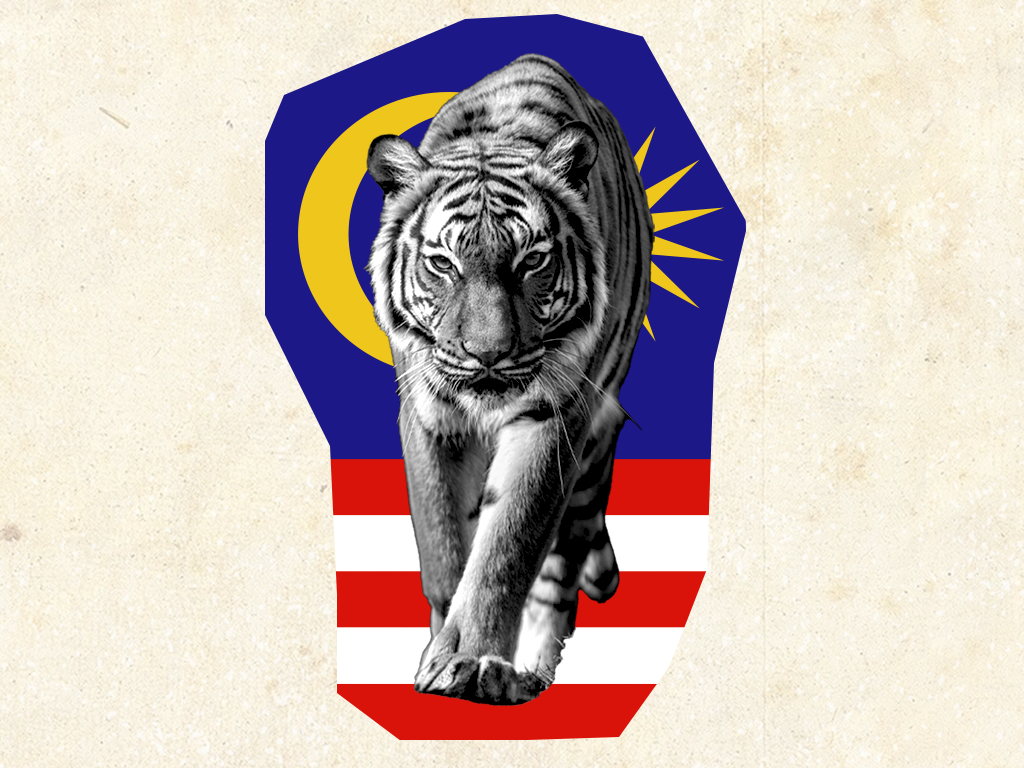Uncle Stripes, or Pak Belang in Malay, is a friendly term for one of Malaysia’s apex predators.
To many, tigers symbolise strength, fearlessness and courage. This is represented in a martial art known as harimau silat, which has movements resembling a tiger. The iconic big cat is also found in the emblems of Malaysia’s national police force, bank, football team and, more importantly, the coat of arms with two tigers holding up the crest.
The Malayan tiger, which was only recognised as its own subspecies in 2004, is considered the national animal of Malaysia, despite the lack of an official law or declaration. Previously, the Malayan tiger was thought to be a subspecies of the Indochinese tiger.
“For me the tiger is not just another charismatic species. When I was a kid, I used to read books that always portrayed the tiger as the king of the jungle,” said Dr. Mark Rayan Darmaraj, country director of the Wildlife Conservation Society in Malaysia. “Tigers are the protectors of the forest and all its beings in it.”
The black-and-orange predator, however, has been threatened by poachers and habitat loss for decades.
With estimates of only a few hundred tigers left in the Malay Peninsula, the Malayan tiger is listed as “critically endangered” on the International Union for Conservation Nature’s Red List of threatened species.
Tiger parts, such as bone, have been used in traditional medicine for centuries, believed to be beneficial for treating illnesses or as an aphrodisiac. Its meat is also believed to strengthen vitality.
“It is a cultural thing that has been handed down for generations. We can’t just eliminate it,” said Dr. Sivananthan Elagupillay, advisor to the Department of Wildlife and National Parks and policy advisor to the Malaysian Conservation Alliance for Tigers. “But one thing we can do is prevent people from going in [to poach].”
Communities close to the forest can recognise the tigers by its stripes, as no two stripes are alike.
“Even in its death, the tiger commands respect,” said Elagupillay, borrowing part of a Malay proverb. “‘When a tiger dies, it leaves behind its stripes.’ When a tiger is dead, people will skin the tiger and put up its skin.”
In addition to the threat of hunting, forest areas are diminishing and shrinking populations of sambar deer, one of the Malayan tiger’s top prey species.
Under the supervision of the wildlife and national parks department, the sambar deer, barking deer and gaur are being bred in captivity and occasionally relocated into tiger habitats in hopes of stimulating the tiger population.
“Our tigers are at the brink of extinction,” Darmaraj said. “If we ever had a chance to save them before being too late, it will be now, where strategic intervention is critically needed.”
“It is our national animal. So if it goes extinct, then what animal is going to represent our country?” Elagupillay said. ”We need more boots on the ground to patrol the tiger habitats and protect these species.”
The National Zoo of Malaysia is home to eight Malayan tigers, including resident tigers named Hebat, Wira, Jati and Kela. “It is easier to bond with the tigers than with humans,” said Jamsary Muhammad, curator of the Malayan tiger exhibition at the zoo.
“Everyone has to play their part in saving our tiger,” Jamsary said. “If we fail, the only Malayan tigers that the future generation will come to know are the tigers on our logos.”
In recent years, government agencies have ramped up efforts to curb poaching, illegal wildlife trade and breeding programs. The National Tiger Conservation Task Force had its first meeting in January, which was chaired by Prime Minister Ismail Sabri Yaakob.
These efforts have given conservationists a glimmer of hope that Malaysia can restore the population of the endangered carnivore.
“My sincere hope is that we will succeed in saving the king of the Malayan jungle for future generations to experience, cherish and be proud of in our country,” Darmaraj said. “If we can’t save our tigers, what will the future hold for other wildlife in Malaysia?”
This article is part of Southeast Asia Globe’s World Wildlife Day Special series.

